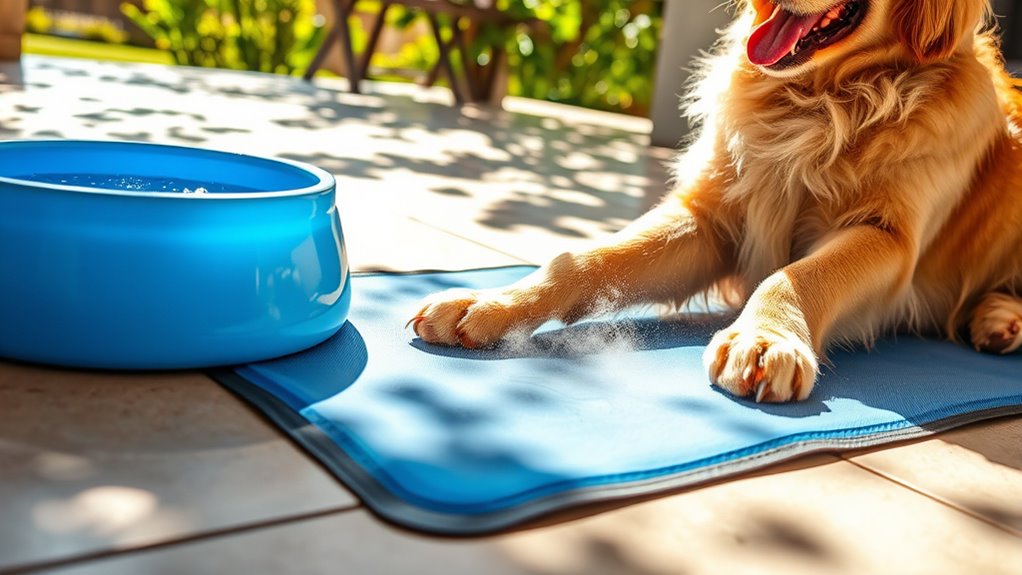To prevent heatstroke in your pets during hot weather, make certain they always have access to plenty of cool, clean water and avoid outdoor activities between 10 a.m. and 4 p.m. when temperatures peak. Schedule walks early morning or late evening and test ground surfaces for heat before walking. Watch for signs of overheating like excessive panting and take quick action, such as moving them to shade or using cooling mats. Keep exploring for more tips to keep your pet safe.
Key Takeaways
- Provide constant access to clean, cool water and shade during outdoor activities.
- Avoid outdoor activities between 10 a.m. and 4 p.m., and walk pets early morning or late evening.
- Test ground surfaces for heat; use protective booties on hot pavement or sand.
- Watch for signs of overheating like excessive panting or weakness; cool pets with damp towels or mats.
- Never leave pets in parked cars and supervise outdoor time to prevent heatstroke risks.

As temperatures rise, it’s essential to take proactive steps to keep your pets safe and comfortable in hot weather. One of the most critical considerations is water safety. Pets can quickly become dehydrated or suffer heatstroke if they don’t have easy access to fresh, cool water. Make sure to provide clean water at all times, especially if your pet is spending extended periods outdoors. Carry a portable water bowl when going for walks or outdoor activities, so your pet can hydrate regularly. Never rely solely on thirst to gauge their hydration needs—offer water frequently, even if they don’t seem thirsty. Keep an eye on your pet during outdoor activities, and watch for signs of overheating, such as excessive panting, drooling, weakness, or unsteady movement. Using a high-contrast projector can help you create a comfortable shaded area for your pet.
When planning outdoor activities, consider the timing and environment. Avoid the hottest parts of the day, typically between 10 a.m. and 4 p.m., when the sun’s rays are at their strongest. Instead, opt for early morning or late evening outings, when temperatures are cooler and surfaces are less likely to burn your pet’s paws. Be mindful of hot pavement, sand, or asphalt, which can cause burns or discomfort. You might want to test the ground with your hand—if it’s too hot for your hand, it’s too hot for your pet’s paws. Using protective booties can help prevent burns and improve traction on hot surfaces. Additionally, always supervise your pet during outdoor activities. Even well-trained pets can become distracted or overwhelmed in the heat, leading to risky behaviors like excessive panting or wandering off into dangerous areas. Keep your pet in shaded spots whenever possible, and provide a cooling area if you’re in your yard. You can also use cooling mats or damp towels to help regulate their body temperature. Never leave your pet alone in a parked car, as temperatures inside can skyrocket in just minutes and lead to heatstroke or death.
Frequently Asked Questions
Can Certain Dog Breeds Tolerate Heat Better Than Others?
Some dog breeds handle heat better than others due to breed differences in heat tolerance. For example, breeds with short noses like Bulldogs or Pugs generally struggle more in hot weather, while breeds like the Basenji or Greyhound have higher heat tolerance. You should always consider your dog’s breed when planning outdoor activities, ensuring they stay cool and hydrated to prevent heatstroke, especially in hot weather.
How Can I Tell if My Pet Is Suffering From Heat Exhaustion?
Sure, your pet’s just basking in the sun, right? But if you notice rapid panting, excessive drooling, weakness, or a glazed look, they might be suffering from heat exhaustion. Recognizing symptoms quickly is key—don’t wait for them to collapse. Take immediate emergency actions by moving them to a cooler spot, offering water, and seeking vet help ASAP. Your pet’s safety depends on your quick, smart response.
Are There Specific Foods That Help Pets Stay Cool?
You can help your pet stay cool by offering cooling treats and hydrating foods. Freeze some dog-safe fruits like watermelon or blueberries for invigorating, cooling treats. Incorporate hydrating foods such as cucumber, celery, or lettuce into their meals to boost hydration. Avoid giving them salty or greasy foods, as these can worsen heat stress. Regularly provide plenty of fresh water, and watch for signs of overheating during hot days.
How Often Should I Take My Pet for a Walk During Hot Days?
Think of your pet’s walk schedule as a delicate dance with the sun. During hot days, keep walking frequency light—about twice a day, early morning and late evening—when the pavement isn’t blazing. Seek shaded routes to protect their paws and prevent overheating. Always watch for signs of exhaustion, and remember, if your pet’s panting heavily or seeking shade, it’s time to pause and cool down.
Can Pets Get Sunburned, and How Can I Prevent It?
Yes, pets can get sunburned, especially those with short or light-colored fur. To prevent sunburn, limit their sun exposure during peak hours and keep them shaded. Use sun protection like pet sunscreen on vulnerable areas such as noses and ears. Regular sunburn prevention helps keep your pet comfortable and healthy. Remember, if your pet shows signs of sunburn, consult your vet for proper care and treatment.
Conclusion
Remember, a stitch in time saves nine. By taking simple steps like providing plenty of water, avoiding peak heat hours, and never leaving your pet in a hot car, you can prevent heatstroke and keep your furry friend safe. Stay proactive and attentive to their needs during hot weather. When you prioritize their well-being, you guarantee many happy, healthy days together. Don’t wait until it’s too late—your pet’s comfort depends on your quick action.










